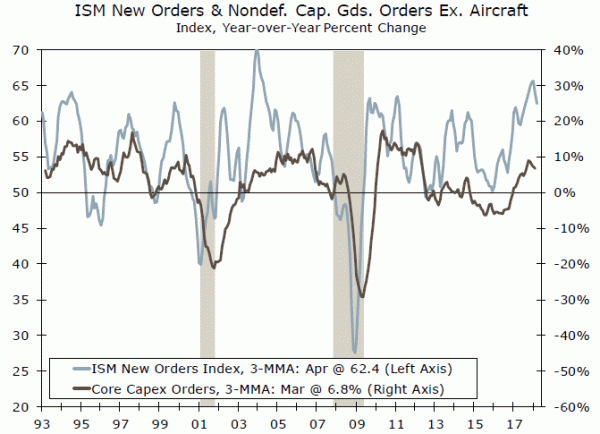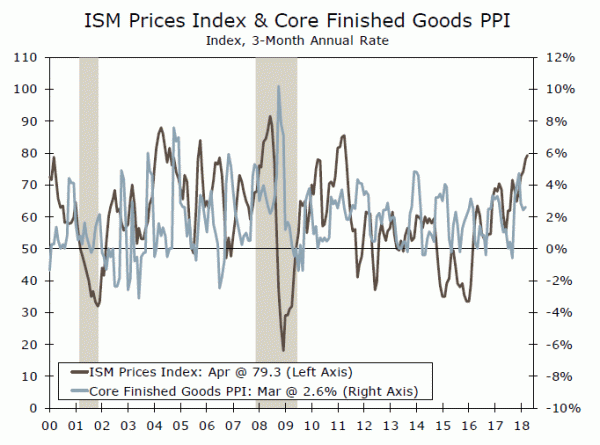The ISM purchasing managers index came in at 57.3—a moderation in line with regional indices. Production, new orders and employment remain in expansion mode. Problems are still brewing in the rise in prices paid.
Growth Remains the Headline Story: But What About Prices?
Moderation in the ISM index is in line with regional indices, while remaining consistent with GDP growth. Seventeen of 18 industries reported growth in April, a repeat from March, led by wood, electrical equipment, appliances and fabricated metals. As seen in the top graph, the ISM manufacturing index is consistent with gains in industrial production this year.
For the ISM production subcomponent, the index had been above 60 for ten straight months but dipped to 57.2 in April. The ISM report reiterated last month’s concerns that labor constraints and supply chain disruptions are limiting production potential. Fifteen industries reported growth in production, led by furniture, apparel and electrical equipment.
Employment registered 54.2 in April and has been above the 50 breakeven level since October 2016. Twelve of the 18 industries reported growth in employment, including paper, fabricated metals and machinery. Our outlook remains for near three percent GDP growth for the rest of 2018.
New Orders: Signal for Continued Growth Ahead
New orders registered 61.2 in April, a slight dip from 61.9 in March, but continues to signal growth in new orders by remaining above 60 since April 2017. The index corroborates the gains in core capital goods orders shown in the middle graph. Sixteen of the 18 industries reported growth in new orders, including wood, furniture, plastics and rubber.
Prices Paid a Warning Sign for Profits—and Trade
The prices index has been above 70 all year, rising to 79.3 in April, which is the highest print in seven years. The rise in the index follows the path of core finished goods PPI (bottom graph). In April, 61.2 percent of respondents reported paying higher prices. Of the industries, seventeen reported paying higher prices, including apparel, textile mills, furniture, fabricated metals and electrical equipment.
To corroborate the price pressures, supplier deliveries remained above 60 for the third consecutive month, indicating slower deliveries to meet orders. Sixteen industries reported slower deliveries, including apparel, machinery, fabricated metals and textiles. Commentary from survey respondents highlighted the issue of labor shortages, transportation delays and tariff uncertainties.
This report reinforces our outlook for continued increases in the PCE deflator and the employment cost index for 2018. While output has improved, the bigger story from the ISM release is the rise in uncertainty on supply chain availability and rising prices paid for inputs. Higher input prices could weigh on profit margins, causing upward pressure on inflation. Similarly, a higher level of uncertainty will impact economic actions going forward and, in our view, lead to higher inflation and thereby continued Fed rate increases this year.















